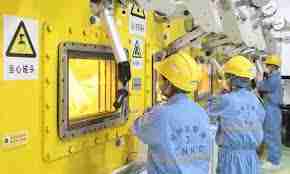The nuclear waste management market is a critical component of the nuclear energy sector, focusing on the safe handling, treatment, storage, and disposal of radioactive waste. As nuclear power continues to play a significant role in the global energy mix, strategic moves by key players in the market are shaping its trajectory. These strategies aim to address technical challenges, regulatory requirements, environmental concerns, and public acceptance while fostering innovation and operational efficiency.

Strategic Focus on Technology Innovation
A primary strategic move within the nuclear waste management market is the investment in advanced technologies designed to improve waste treatment and disposal processes. Companies and governments are channeling resources into research and development for innovations such as:
Partitioning and Transmutation: Techniques aimed at reducing the volume and toxicity of high-level nuclear waste by separating and transforming long-lived radioactive isotopes into shorter-lived or stable elements.
Vitrification: The process of immobilizing radioactive waste in glass, enhancing its stability and safety for long-term storage.
Advanced Dry Cask Storage Systems: Developing modular, scalable, and safer storage solutions that facilitate easier handling and monitoring of spent nuclear fuel.
Robotics and Automation: Employing robotic systems for remote handling and processing to reduce human exposure to radiation and improve operational precision.
These innovations not only enhance safety but also extend the lifecycle of storage facilities and reduce overall costs, providing competitive advantages to companies that adopt them.
Collaboration and Partnerships
Strategic alliances between governments, private companies, research institutions, and international organizations are central to advancing nuclear waste management. Such collaborations help pool expertise, share risks, and accelerate the development and deployment of new technologies.
Public-private partnerships (PPPs) have become increasingly common, enabling more efficient allocation of resources and fostering innovation. Governments provide regulatory frameworks and funding support, while private entities bring technological expertise and operational capabilities.
International collaboration is also crucial, as nuclear waste management involves cross-border challenges such as regulatory harmonization, transportation logistics, and knowledge exchange. Programs under agencies like the International Atomic Energy Agency (IAEA) facilitate cooperation and establish global safety standards.
Regulatory Compliance and Policy Advocacy
Navigating complex regulatory environments is a significant strategic focus for market players. Compliance with national and international regulations is mandatory for licensing, construction, operation, and closure of waste management facilities.
Market leaders actively engage in policy advocacy to influence regulations that are conducive to innovation and market growth. This includes pushing for streamlined licensing processes, harmonized safety standards, and clear guidelines for emerging technologies.
Companies also invest in building strong relationships with regulators and local communities to foster transparency and trust, which are vital for securing project approvals and maintaining social license to operate.
Enhancing Public Engagement and Social Acceptance
Public opposition has historically posed challenges to nuclear waste management projects. To address this, strategic moves increasingly focus on improving community engagement and building social acceptance.
Market participants deploy educational campaigns, public consultations, and stakeholder involvement initiatives to demystify nuclear waste issues and communicate safety measures. Transparent disclosure of project information and environmental impact assessments help build confidence.
Some companies adopt benefit-sharing models, offering economic incentives or community development programs to garner local support. These efforts reduce resistance, mitigate delays, and enable smoother project execution.
Financial Strategies and Risk Management
Given the high capital intensity and long timelines of nuclear waste management projects, financial strategy is paramount. Companies and governments employ various approaches to manage costs and risks effectively:
Long-term Funding Mechanisms: Establishing dedicated funds or trust accounts to ensure availability of resources for waste management throughout a project’s lifespan, including post-closure monitoring.
Cost-sharing Models: Collaborating with multiple stakeholders to distribute financial responsibilities and minimize individual burdens.
Risk Mitigation: Utilizing insurance, hedging, and contingency planning to address uncertainties related to regulatory changes, technical failures, or social opposition.
By strengthening financial resilience, market players improve project viability and attract further investment.
Expanding Geographic Footprint
Strategic geographic expansion is another key move in the nuclear waste management market. With the global growth of nuclear power, especially in emerging economies, companies are exploring new regions to offer their expertise and technologies.
Entering developing markets requires adapting solutions to local regulatory environments and infrastructure capabilities. This expansion helps diversify revenue streams and strengthens global presence.
Moreover, some firms target regions with aging nuclear reactors requiring decommissioning and legacy waste management, leveraging opportunities in remediation and site restoration services.
Focus on Sustainability and Environmental Responsibility
Sustainability has become an integral part of strategic planning in nuclear waste management. Companies are aligning their operations with environmental goals by adopting greener technologies and minimizing ecological footprints.
This includes developing waste reduction technologies, implementing recycling initiatives for nuclear materials, and ensuring that disposal methods protect biodiversity and natural resources.
Sustainability efforts also improve corporate reputation and meet the increasing expectations of regulators, investors, and the public.
Talent Development and Knowledge Management
Given the specialized nature of nuclear waste management, strategic human resource development is critical. Companies invest in training programs, apprenticeships, and partnerships with academic institutions to build and retain skilled workforces.
Knowledge management initiatives ensure that expertise is preserved and transferred, mitigating risks associated with workforce aging and turnover.
Such investments enhance operational safety, innovation capacity, and compliance with stringent safety standards.
Conclusion
The nuclear waste management market is evolving through a series of strategic moves that address technological, regulatory, financial, social, and environmental challenges. Innovation in treatment technologies, collaborative partnerships, regulatory advocacy, public engagement, financial planning, geographic expansion, sustainability focus, and talent development collectively drive market growth and resilience.
These strategies position the nuclear waste management sector to meet current demands and future challenges, ensuring the safe and responsible handling of radioactive waste worldwide. As nuclear energy continues to be an essential part of global energy portfolios, the importance of strategic management in this market will only increase.



